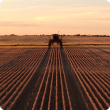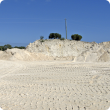Grains Research & Development
The Department of Primary Industries and Regional Development has grains research and development connections across Australia and with more than 25 countries worldwide – ranging from collaboration with Japanese flour millers involved with the udon noodle industry through to seeking out barley genes tolerant of acid soils on the Tibetan Plateau and commercialising department-bred lupin varieties for use in the Chilean salmon industry.
These research, development and extension linkages and partnerships underpin the department’s capacity to tackle grains issues of national and regional agricultural importance and deliver profitable management solutions to the state’s 4000 grain producers.
The department is committed to leading and contributing to specific priority areas of research and development through the Grains Industry National Research, Development and Extension (RD&E) Strategy.
The Grains Research and Development Corporation (GRDC) – a national organisation coordinating research and development of behalf of Australian grain growers is a key funder of the department's grain research, development and extension activities.
Major initiatives being undertaken through the GRDC-DPIRD partnership include developing solutions to frost and soil constraints, which together can cost the Western Australian grains industry hundreds of millions of dollars in lost production each year.
Filter by search
Filter by topic
- (-) Remove Soils filter Soils
- Climate, land & water (23) Apply Climate, land & water filter
- Grains research & development (21) Apply Grains research & development filter
- Managing soils (17) Apply Managing soils filter
- Production & postharvest (12) Apply Production & postharvest filter
- Soil management (12) Apply Soil management filter
- Soil acidity (11) Apply Soil acidity filter
- Liming (10) Apply Liming filter
- Water repellence (7) Apply Water repellence filter
- Wheat (6) Apply Wheat filter
- Soil constraints (5) Apply Soil constraints filter
- Soil compaction (3) Apply Soil compaction filter
- Pests, weeds & diseases (2) Apply Pests, weeds & diseases filter
- Lupins (2) Apply Lupins filter
- Weeds (2) Apply Weeds filter
- Soil nutrients (2) Apply Soil nutrients filter
- Crop weeds (2) Apply Crop weeds filter
- Canola (2) Apply Canola filter
- Barley (2) Apply Barley filter
- Climate & weather (2) Apply Climate & weather filter
- Pastures (1) Apply Pastures filter
- Pasture management (1) Apply Pasture management filter
- Oats (1) Apply Oats filter
- Plant nutrition (1) Apply Plant nutrition filter
- Soil water (1) Apply Soil water filter
- Waterlogging (1) Apply Waterlogging filter
- Water erosion (1) Apply Water erosion filter
- Measuring and assessing soils (1) Apply Measuring and assessing soils filter
- Pulses (1) Apply Pulses filter
- Livestock & animals (1) Apply Livestock & animals filter
- Diseases (1) Apply Diseases filter
- Crop diseases (1) Apply Crop diseases filter
- Climate change (1) Apply Climate change filter
- Feeding & nutrition (1) Apply Feeding & nutrition filter
- Frost (1) Apply Frost filter
- Livestock management (1) Apply Livestock management filter
- Genetics & selection (1) Apply Genetics & selection filter
- Livestock research & development (1) Apply Livestock research & development filter









